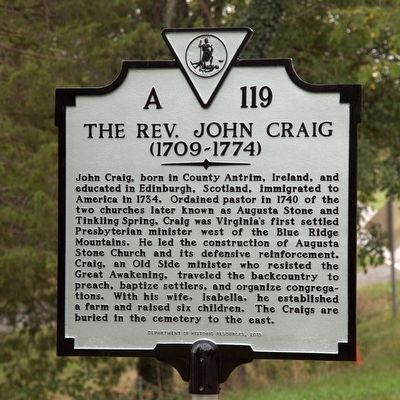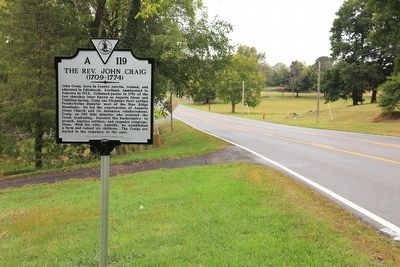Fort Defiance in Augusta County, Virginia — The American South (Mid-Atlantic)
The Rev. John Craig
(1709–1774)
Erected 2015 by Department of Historic Resources. (Marker Number A-119.)
Topics and series. This historical marker is listed in these topic lists: Churches & Religion • Notable Events. In addition, it is included in the Virginia Department of Historic Resources (DHR) series list. A significant historical year for this entry is 1740.
Location. 38° 14.27′ N, 78° 58.468′ W. Marker is in Fort Defiance, Virginia, in Augusta County. Marker is on Lee Highway (U.S. 11) just south of County Route 616, on the left when traveling south. Touch for map. Marker is in this post office area: Fort Defiance VA 24437, United States of America. Touch for directions.
Other nearby markers. At least 8 other markers are within walking distance of this marker. Augusta Stone Church (within shouting distance of this marker); a different marker also named Augusta Stone Church (within shouting distance of this marker); Augusta Military Academy (about 700 feet away, measured in a direct line); Quarles Walk (approx. 0.2 miles away); This 1886 Bell (approx. 0.2 miles away); Augusta Military Academy Museum (approx. 0.2 miles away); a different marker also named Augusta Military Academy (approx. 0.2 miles away); Dwight D. Eisenhower Visits Augusta Military Academy (approx. 0.2 miles away). Touch for a list and map of all markers in Fort Defiance.
Also see . . . My Geneology Home Page: Information About John Craig. “Let us now refer again to the Rev John Craig and his narrative. The territory occupied by his congregation was ‘about thirty miles in length and nearly twenty in breadth. The people agreed to have two meeting houses, expecting to have two congregations, as afterwards came to pass.’ The people of the Augusta, or stone church neighborhood, amongst whom Mr. Craig lived, ‘were fewer in numbers, and much lower as to their worldly circumstances, but a good natured, prudent, governable people, and liberally bestowed a part of what God gave them for religious and pious uses; always unanimous among themselves.’ ‘I have no trouble with them,’ says Mr. Craig, ‘about their meeting house. They readily fixed on the place, and agreed on the plan for building, it, and contributed cheerfully, money and labor to accomplish the work, all in the voluntary way, what every man pleased.’ But the people of the other section were, according to Mr. Craig’s way of thinking, a stiff-necked and perverse generation. He says: ‘That part now called Tinkling Spring was most in numbers, and richer than the other, and forward, and had the public management of the affairs of the whole settlement; their leaders close-moused about providing necessary things for pious and religious uses, and could not agree for several years upon a plan or manner, where or how to build their meeting-house, which gave me very great trouble to hold them together, their disputes ran so high. A difference happened between Colonel John Lewis and Colonel James Patton, both living in that congregation, which was hurtful to the settlement but especially to me. I could neither bring them to friendship with each other, or obtain both their friendships at once, ever after. This continued for thirteen or fourteen years, till Colonel Patton was murdered by the Indians. At that time he was friendly with me. After his death, Colonel Lewis was friendly with me till he died’.” (Submitted on September 27, 2015.)
Credits. This page was last revised on September 2, 2020. It was originally submitted on September 27, 2015. This page has been viewed 968 times since then and 100 times this year. Last updated on August 30, 2020, by Bradley Owen of Morgantown, West Virginia. Photos: 1, 2. submitted on September 27, 2015, by J. J. Prats of Powell, Ohio. • J. Makali Bruton was the editor who published this page.

